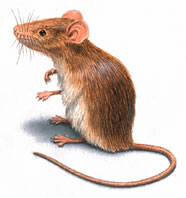Appearance:
Small and slender, three to four inches long, with large ears, small eyes and pointed nose. Light brown or light gray. Droppings are rod-shaped.
Habit:
Nests within structures and burrows. Establish a "territory" near food sources that are generally 10 to 30 feet from nest. Inquisitive, but very wary. Excellent climbers.
Diet:
Omnivorous, but prefers cereal grains.
Reproduction:
Prolific breeders by two months of age. Can have litters as often as every 40 or 50 days, with four to seven young per litter. Live up to one year.

House Mouse
Appearance:
Brown, heavy-bodied, six to eight inches long, with small eyes and ears and blunt nose. Tail is shorter than head and body. Its fur is shaggy. Droppings are capsule-shaped.
Habit:
Nests in underground burrows, from which they enter buildings in search of food. Tends to remain in hiding during the day.
Diet:
Omnivorous, but prefers meats. Cannot survive long without water.
Reproduction:
Reaches sexual maturity in two months and can breed any month of the year. Litter may number from eight to twelve. Females can have four to seven litters per year. Adults live as long as one year.

Norway Rat
Appearance:
Black or brown, seven to 10 inches long, with a long tail, large ears and eyes, and a pointed nose. Body is smaller and sleeker than Norway rat. Fur is smooth.
Habit:
Nests inside and under buildings, or in piles of rubbish or wood. Excellent climber that can often be found in the upper parts of structures.
Diet:
Omnivorous, but shows a preference for grains, fruits, nuts and vegetables.
Reproduction:
Becomes sexually mature at four months, producing four to six litters per year that consist of four to eight young each. Lives up to one year.

--------------------------------------------------------------------------------------------------------------
-------------------------------------------------------------------------------------------------------------
Always ready to serve You - 301-731-2024
Important Disease Information:
Rodents, which can be hard to control, may also be harmful, contaminating food and spreading diseases. Mice alone contaminate 10 times the amount of food they actually consume. The Centers for Disease Control and Prevention (CDC) states that 406 cases of hantavirus pulmonary syndrome, one of the many diseases carried and transmitted by various rodent species, have been reported in the United States since the disease was first recognized in 1993. Thirty-six percent of all reported cases have resulted in death. Additionally, rodents can carry fleas known to spread various types of plague and other diseases such as Lymphocytic choriomeningitis virus (LCMV). The house mouse is the primary carrier of LCMV, which causes symptoms such as headache, fever, chills, muscle aches and even meningitis (inflammation around the brain and spinal cord). Typically, however, LCMV has little effect on people with normal immune systems, but has been known to cause serious infections in people with weakened immune systems. Women who become infected with LCMV during pregnancy may experience severe complications.
Home Privacy Policy Family Careers Feedback Pest Control Termite Control Commercial Contact Us Links
